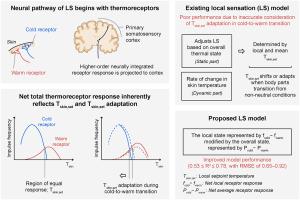Incorporating thermoreceptor responses in a local sensation model to account for setpoint adaptation during cold-to-warm transition
IF 2.9
2区 生物学
Q2 BIOLOGY
引用次数: 0
Abstract
The Berkeley comfort models are well-suited for addressing nonuniform, transient, and cold conditions owing to their comprehensible model structures. Integrating these models with thermoregulation models can aid in formulating energy-efficient local warming and heating, ventilation, and air conditioning (HVAC) operational strategies for occupant-centric winter conditioning in battery electric vehicles (BEVs)—a critical step toward their widespread adoption. However, the Berkeley local sensation (LS) model requires accurate consideration of setpoint and setpoint adaptation to ensure reliable predictions. Since the dynamic responses and excitatory–inhibitory interactions between the cold- and warm-sensitive thermoreceptors may inherently entail setpoint adaptation, expressing the LS model in terms of the receptor responses offers a promising alternative. This study evaluates a thermoreceptor-response-based LS model by incorporatingnet cold- and warm-sensitive receptor responses into the existing framework. Model coefficients were regressed and tested on two independent datasets from experiments simulating routine cabin environments during outdoor winter conditions. The results showed a reasonable fit for the development dataset A, with root mean-squared error (RMSE) values in the range of 0.29–0.59 and coefficient of determination (R2) values of 0.65–0.92. Validation on the test dataset B yielded RMSE values of 0.5–0.92 and moderate-to-strong R2 values of 0.53–0.78. Compared to the original Berkeley LS model, the proposed receptor-response-based model demonstrated improved performances across all body segments. Moreover, this new framework has the potential to eliminate the need for explicit setpoint and setpoint adaptation definitions while offering a viable solution for optimizing local warmer and HVAC operating strategies in BEVs operating under outdoor winter conditions.

在局部感觉模型中纳入热感受器反应,以解释冷到暖过渡期间的设定值适应。
由于其可理解的模型结构,伯克利舒适模型非常适合于解决不均匀,瞬态和寒冷条件。将这些模型与温度调节模型相结合,可以帮助制定以乘员为中心的纯电动汽车(bev)冬季空调的节能局部供暖、供暖、通风和空调(HVAC)操作策略,这是广泛采用纯电动汽车的关键一步。然而,伯克利局部感觉(LS)模型需要准确地考虑设定值和设定值适应,以确保可靠的预测。由于冷敏和热敏热感受器之间的动态反应和兴奋-抑制相互作用可能固有地需要设定点适应,因此根据受体反应表达LS模型提供了一个有希望的替代方案。本研究通过将冷敏和热敏受体反应纳入现有框架,评估了基于热敏受体反应的LS模型。模型系数回归并在两个独立的数据集上进行测试,这些数据集来自模拟室外冬季常规舱室环境的实验。结果表明,该模型与发展数据a拟合较好,均方根误差(RMSE)在0.29 ~ 0.59之间,决定系数(R2)在0.65 ~ 0.92之间。在测试数据集B上验证的RMSE值为0.5-0.92,中至强R2值为0.53-0.78。与最初的Berkeley LS模型相比,提出的基于受体反应的模型在所有身体部位都表现出更好的性能。此外,这个新框架有可能消除对明确设定值和设定值自适应定义的需求,同时为在室外冬季条件下运行的纯电动汽车优化本地暖气和暖通空调运行策略提供可行的解决方案。
本文章由计算机程序翻译,如有差异,请以英文原文为准。
求助全文
约1分钟内获得全文
求助全文
来源期刊

Journal of thermal biology
生物-动物学
CiteScore
5.30
自引率
7.40%
发文量
196
审稿时长
14.5 weeks
期刊介绍:
The Journal of Thermal Biology publishes articles that advance our knowledge on the ways and mechanisms through which temperature affects man and animals. This includes studies of their responses to these effects and on the ecological consequences. Directly relevant to this theme are:
• The mechanisms of thermal limitation, heat and cold injury, and the resistance of organisms to extremes of temperature
• The mechanisms involved in acclimation, acclimatization and evolutionary adaptation to temperature
• Mechanisms underlying the patterns of hibernation, torpor, dormancy, aestivation and diapause
• Effects of temperature on reproduction and development, growth, ageing and life-span
• Studies on modelling heat transfer between organisms and their environment
• The contributions of temperature to effects of climate change on animal species and man
• Studies of conservation biology and physiology related to temperature
• Behavioural and physiological regulation of body temperature including its pathophysiology and fever
• Medical applications of hypo- and hyperthermia
Article types:
• Original articles
• Review articles
 求助内容:
求助内容: 应助结果提醒方式:
应助结果提醒方式:


